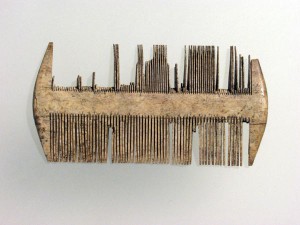
The number of preventive excavations has increased in the past decades, thus, it has now become possible to re-examine the connections between animals and people in Roman Aquincum in a multiplicity of new ways.
Roman society was complex, hierarchical and multiethnic in the provinces. This situation is also reflected in the animal bones, as well as the tools and jewellery made from them. Through examining the ratio of animal species and how they were butchered, it is possible to ascertain that the Romanised Celtic population – living in the territory of Aquincum – took the animals into their villages to slaughter, butcher and prepare them in a traditional way. In contrast, the inhabitants of the town used a centralised meat processing system: the animals were butchered away from the populated areas while meat processing and further cutting up of the carcasses was carried out by butchers. Finally, meat was sold in the town’s macellum (or meat market).
While meat and leather mainly derived from domestic animals (nearly 99%), the ratio of the beef, lamb, pork, goat and chicken intended for consumption was different for various ethnic groups. Differences were probably related to dietary customs. Thus, the ratio of pig bone fragments in Aquincum is usually lower than in the other towns of the Roman Empire over the same period. It is feasible that these lower than expected numbers are related to the large number of soldiers of Eastern origin stationed in Aquincum, a proportion of whom might have been prohibited from consuming pork. Domestic animals further included dogs, cats, rabbits, horses, donkeys, mules, chickens and geese. They also ate fish, especially carp, which likely came from fisheries.
People from poorer social classes probably ate less meat. After older animals could no longer be used for work, they were taken to the market, butchered and their meat was sold. Wealthy customers could afford the veal, lamb and piglet meat. They even consumed oysters and bird tongues.
They did not eat dogs or horse. They bred small, bow-legged lap-dogs and wolf-sized hunting or guard dogs. Their bones could be found scattered in Roman towns. The absence of gnawed bones, however, indicates that they were not allowed to wander around freely in urban areas. In contrast, dogs seem to have been able to rummage freely in the household rubbish in the villages of the indigenous population. We rarely find horse bones in urban areas, although their bones were used regularly to manufacture tools or jewellery. Horses symbolised the high rank of military officers. Mule and donkey bones are also found in refuse pits of military buildings and villas, where they served as important pack animals.Based on the injuries found on their bones, it may be surmised that they were also used as draught animals.
Cow, sheep and goat milk products were certainly consumed. Wool was an important secondary product of sheep, although in the Aquincum area it was mainly produced for local consumption.
The situation was different in the fortresses and the villages surrounding them. The traces of the butchering techniques indicate that the soldiers’ food, in addition to the staple grain products, included, especially in the winter, dired and smoked meat. The soldiers also ate meat from wild animals including red deer, wild boar and fish, to help make their somewhat one-dimensional diet more varied.
Further research aims to shed more light on the utilisation of the animals’ meat, draught power, integument, bones, the glue made from processing the nonmeaty limb bones and – in the case of horned animals – how the horn was made use of. We would like to know the ways in which the role of animals changed and varied in the more than 400 years of Roman occupation of Aquincum, and how they were utilised by other peoples.
The curator of the collection: Zsófia Anna Biller


